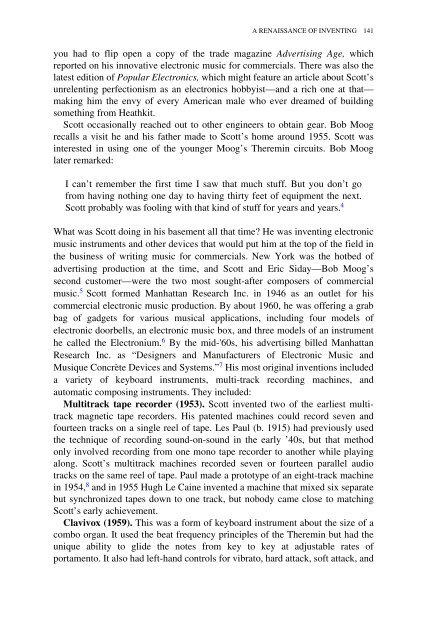Electronic and Experimental Music: Pioneers in ... - Aaaaarg
Electronic and Experimental Music: Pioneers in ... - Aaaaarg
Electronic and Experimental Music: Pioneers in ... - Aaaaarg
You also want an ePaper? Increase the reach of your titles
YUMPU automatically turns print PDFs into web optimized ePapers that Google loves.
A RENAISSANCE OF INVENTING 141<br />
you had to flip open a copy of the trade magaz<strong>in</strong>e Advertis<strong>in</strong>g Age, which<br />
reported on his <strong>in</strong>novative electronic music for commercials. There was also the<br />
latest edition of Popular <strong>Electronic</strong>s, which might feature an article about Scott’s<br />
unrelent<strong>in</strong>g perfectionism as an electronics hobbyist—<strong>and</strong> a rich one at that—<br />
mak<strong>in</strong>g him the envy of every American male who ever dreamed of build<strong>in</strong>g<br />
someth<strong>in</strong>g from Heathkit.<br />
Scott occasionally reached out to other eng<strong>in</strong>eers to obta<strong>in</strong> gear. Bob Moog<br />
recalls a visit he <strong>and</strong> his father made to Scott’s home around 1955. Scott was<br />
<strong>in</strong>terested <strong>in</strong> us<strong>in</strong>g one of the younger Moog’s Therem<strong>in</strong> circuits. Bob Moog<br />
later remarked:<br />
I can’t remember the first time I saw that much stuff. But you don’t go<br />
from hav<strong>in</strong>g noth<strong>in</strong>g one day to hav<strong>in</strong>g thirty feet of equipment the next.<br />
Scott probably was fool<strong>in</strong>g with that k<strong>in</strong>d of stuff for years <strong>and</strong> years. 4<br />
What was Scott do<strong>in</strong>g <strong>in</strong> his basement all that time? He was <strong>in</strong>vent<strong>in</strong>g electronic<br />
music <strong>in</strong>struments <strong>and</strong> other devices that would put him at the top of the field <strong>in</strong><br />
the bus<strong>in</strong>ess of writ<strong>in</strong>g music for commercials. New York was the hotbed of<br />
advertis<strong>in</strong>g production at the time, <strong>and</strong> Scott <strong>and</strong> Eric Siday—Bob Moog’s<br />
second customer—were the two most sought-after composers of commercial<br />
music. 5 Scott formed Manhattan Research Inc. <strong>in</strong> 1946 as an outlet for his<br />
commercial electronic music production. By about 1960, he was offer<strong>in</strong>g a grab<br />
bag of gadgets for various musical applications, <strong>in</strong>clud<strong>in</strong>g four models of<br />
electronic doorbells, an electronic music box, <strong>and</strong> three models of an <strong>in</strong>strument<br />
he called the Electronium. 6 By the mid-'60s, his advertis<strong>in</strong>g billed Manhattan<br />
Research Inc. as “Designers <strong>and</strong> Manufacturers of <strong>Electronic</strong> <strong>Music</strong> <strong>and</strong><br />
Musique Concrète Devices <strong>and</strong> Systems.” 7 His most orig<strong>in</strong>al <strong>in</strong>ventions <strong>in</strong>cluded<br />
a variety of keyboard <strong>in</strong>struments, multi-track record<strong>in</strong>g mach<strong>in</strong>es, <strong>and</strong><br />
automatic compos<strong>in</strong>g <strong>in</strong>struments. They <strong>in</strong>cluded:<br />
Multitrack tape recorder (1953). Scott <strong>in</strong>vented two of the earliest multitrack<br />
magnetic tape recorders. His patented mach<strong>in</strong>es could record seven <strong>and</strong><br />
fourteen tracks on a s<strong>in</strong>gle reel of tape. Les Paul (b. 1915) had previously used<br />
the technique of record<strong>in</strong>g sound-on-sound <strong>in</strong> the early ’40s, but that method<br />
only <strong>in</strong>volved record<strong>in</strong>g from one mono tape recorder to another while play<strong>in</strong>g<br />
along. Scott’s multitrack mach<strong>in</strong>es recorded seven or fourteen parallel audio<br />
tracks on the same reel of tape. Paul made a prototype of an eight-track mach<strong>in</strong>e<br />
<strong>in</strong> 1954, 8 <strong>and</strong> <strong>in</strong> 1955 Hugh Le Ca<strong>in</strong>e <strong>in</strong>vented a mach<strong>in</strong>e that mixed six separate<br />
but synchronized tapes down to one track, but nobody came close to match<strong>in</strong>g<br />
Scott’s early achievement.<br />
Clavivox (1959). This was a form of keyboard <strong>in</strong>strument about the size of a<br />
combo organ. It used the beat frequency pr<strong>in</strong>ciples of the Therem<strong>in</strong> but had the<br />
unique ability to glide the notes from key to key at adjustable rates of<br />
portamento. It also had left-h<strong>and</strong> controls for vibrato, hard attack, soft attack, <strong>and</strong>












